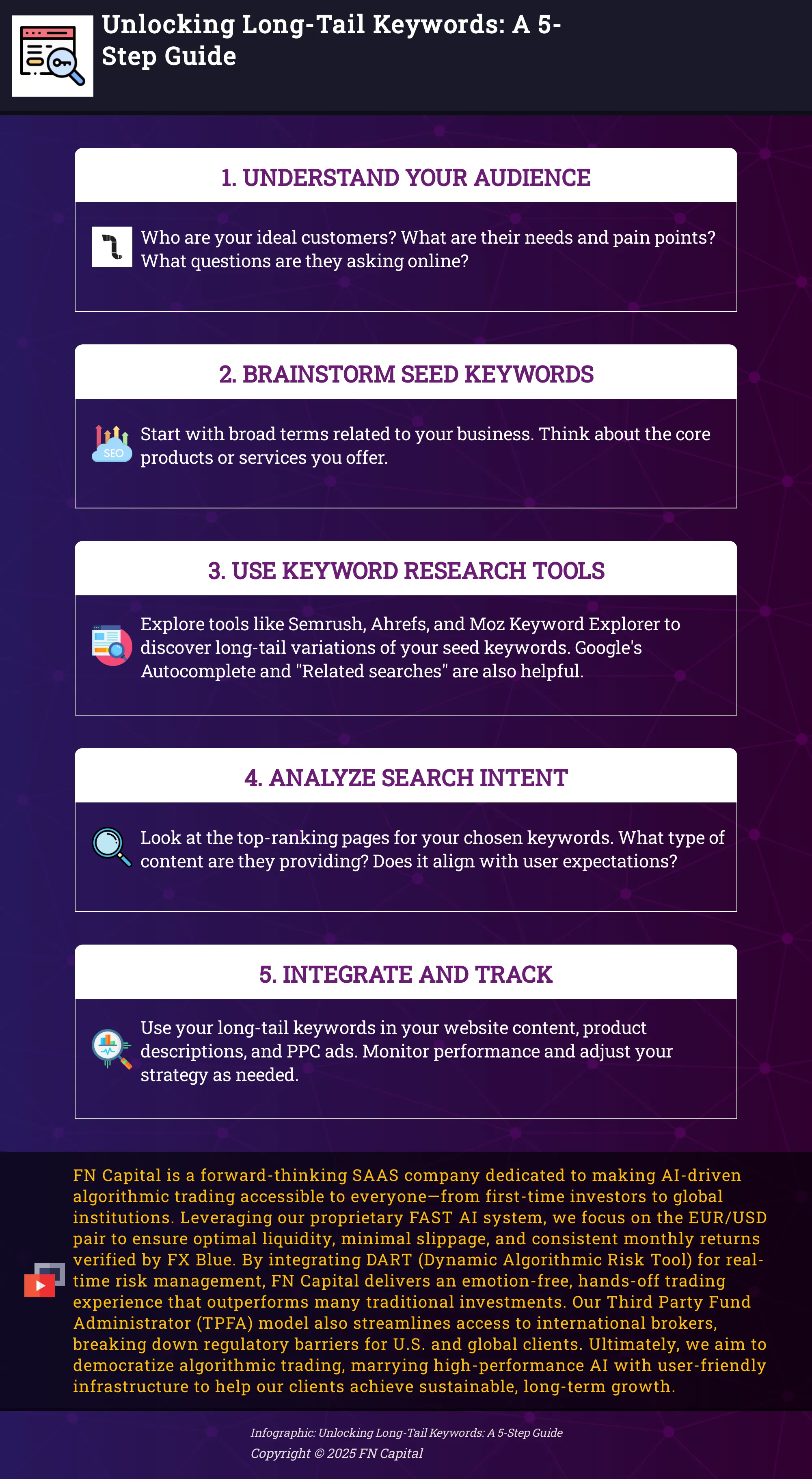In the vast digital ocean, are you fishing with a net or a spear? If you’re casting a wide net with generic keywords, you’re likely catching a lot of irrelevant traffic. But if you want to snag those high-value customers who are ready to buy, you need to get specific. Long-tail keywords are your spear, allowing you to precisely target your ideal audience and reel in those conversions. This guide will equip you with the knowledge and tools to master long-tail keywords, from identifying the right phrases to seamlessly integrating them into your content and PPC campaigns. Get ready to transform your online presence from a small fishing boat to a high-powered yacht, attracting the customers you want and achieving the results you deserve.
Key Takeaways
- Use long-tail keywords to connect with the right customers: These specific phrases help you target user intent, attracting people actively searching for what you offer. Think about the questions your ideal customer asks and answer them with your content.
- Improve your search rankings with less competition: Long-tail keywords offer a less crowded landscape, making it easier to rank higher and gain visibility, especially for newer websites. This targeted approach can drive more qualified traffic to your site.
- Boost conversions and track your success: Long-tail keywords attract users further along in the buying process, leading to higher conversion rates. Regularly monitor your keyword performance and adapt your strategy based on what’s working best. Stay informed about SEO best practices to keep your content discoverable and relevant.
What Are Long-Tail Keywords?
Targeting the right keywords is crucial for attracting potential customers through search engines. While focusing on popular, short keywords might seem appealing, long-tail keywords offer unique advantages. This section explores what long-tail keywords are, their characteristics, and why they’re essential for a successful SEO strategy.
Defining Long-Tail Keywords
Long-tail keywords are longer, more specific search phrases that typically consist of three or more words. Unlike broad, generic keywords, they target niche searches with higher user intent. Think of it this way: someone searching for “shoes” is likely just browsing, but someone searching for “women’s red running shoes size 8” knows exactly what they want and is much closer to making a purchase. Semrush explains long-tail keywords and how to choose them strategically. This precision is what makes long-tail keywords so valuable. They often reflect a stronger purchase intent, as highlighted by Link Assistant, making them ideal for businesses looking to attract qualified leads.
Characteristics and Examples
Long-tail keywords tend to have lower individual search volumes compared to shorter keywords. However, don’t let this discourage you. Collectively, they can drive significant traffic to your website. Indeed emphasizes the importance of targeting these keywords correctly. Their specificity is key. For instance, “fee-only financial planner Riverside County” is far more targeted than simply “financial planner,” as noted by Constant Contact. This example highlights how long-tail keywords cater to specific needs and locations. Similarly, “retirement planning for baby boomers” is a more specific, long-tail keyword compared to the broader “retirement strategies,” according to Steven J. Wilson. By focusing on these niche searches, you connect with users actively seeking precise products or services, ultimately leading to higher conversion rates.
Why Use Long-Tail Keywords?
Long-tail keywords are essential for any SEO strategy. They offer several benefits that can significantly impact your website’s visibility and performance. Let’s explore why you should incorporate them into your content.
Target User Intent
Long-tail keywords, phrases of three or more words, are more specific than shorter keywords. This specificity is key to targeting user intent. When someone searches for “buy red running shoes size 9 women,” they have a clear idea of what they want. This differs from someone simply searching for “shoes,” who might be browsing, researching, or have any number of shoe-related interests. Because long-tail keywords target specific needs, they attract customers who are ready to purchase, making them highly valuable for businesses.
Improve Search Rankings
While short-tail keywords like “coffee” have high search volume, they also face fierce competition. Ranking for such terms can be difficult, especially for newer websites. Long-tail keywords, however, often have lower search volume but significantly less competition. This makes it easier to achieve higher rankings in search results. For example, ranking for “best organic coffee beans for cold brew” is more achievable than ranking for just “coffee.” This improved visibility can drive more targeted traffic to your site.
Increase Conversion Rates
Long-tail keywords not only improve search rankings but also boost conversion rates. Since these keywords target specific user intent, the traffic they generate is more qualified. People searching these terms are further along in the buying process and more likely to convert into paying customers. Studies show that long-tail keywords have a significantly higher conversion rate than short-tail keywords, sometimes as much as 2.5 times higher, according to Link Assistant. This means more leads, sales, and ultimately, a better return on your SEO efforts.
Long-Tail vs. Short-Tail Keywords
This section clarifies the differences between long-tail and short-tail keywords and their impact on search volume, competition, user intent, and your overall SEO strategy. Understanding these distinctions is crucial for a keyword strategy that drives targeted traffic and conversions.
Search Volume and Competition
Long-tail keywords, typically phrases of three or more words, usually have lower individual search volume than shorter keywords. Think “women’s waterproof hiking boots size 8” versus just “boots.” While each long-tail search might be less frequent, together they represent a significant portion of online searches. Link Assistant points out that long-tail keywords comprise the majority of searches, considerably outweighing short-tail keywords. This presents a valuable opportunity to capture a larger audience by targeting a wider range of specific searches. Since fewer websites compete for these niche terms, ranking higher in search results for long-tail keywords is often easier. This lower competition makes them attractive for businesses looking to gain visibility in crowded online marketplaces. Semrush confirms that targeting long-tail keywords correctly can still attract substantial traffic.
User Intent Specificity
Long-tail keywords reveal more about what a user wants. Someone searching for “best Italian restaurants near me open now” has a different intent than someone searching for just “restaurants.” This specificity is invaluable. WordStream explains that users searching long-tail terms are often closer to buying. They’ve moved beyond general browsing and are actively seeking specific products or services. This makes long-tail keywords highly effective for driving conversions. Semrush also highlights the higher conversion likelihood of users making long-tail searches, reinforcing their importance in a targeted marketing strategy. By understanding the specific needs expressed through these searches, businesses can tailor their content and offers to precisely match user intent, leading to higher conversion rates.
Impact on SEO Strategy
Using long-tail keywords strategically strengthens your overall SEO approach. WordStream emphasizes their power in improving search engine rankings and attracting customers ready to buy. By focusing on these specific terms, you’re not just attracting any traffic—you’re attracting traffic that’s highly likely to convert. The reduced competition for long-tail keywords, as noted by Semrush, makes it easier to achieve higher rankings. This improved visibility increases your website’s chances of being discovered by potential customers actively searching for what you offer. Incorporating long-tail keywords into your content strategy lets you address specific customer needs and questions, establishing your website as a relevant and authoritative source. This targeted approach improves search rankings and builds trust with your audience.
How to Find Long-Tail Keywords
Now that you understand the value of long-tail keywords, let’s explore how to uncover these hidden gems for your own SEO strategy. It’s a mix of using the right tools, understanding user behavior, and getting to know your customers better.

Keyword Research Tools and Techniques
Several keyword research tools can help you identify long-tail keywords related to your niche. Semrush, for example, offers a suite of tools like the Keyword Magic Tool, Keyword Gap tool, and Topic Research tool to discover relevant long-tail keywords that your audience is searching for. Ahrefs and Moz Keyword Explorer are also excellent resources for uncovering valuable long-tail opportunities. Think of these tools as your treasure map, guiding you toward keywords your competitors might be missing.
Beyond dedicated keyword tools, you can leverage some handy features directly within Google. Start typing a search query and see what Google suggests in the Autocomplete feature—these are often long-tail keywords that people frequently search. Also, check the “Related searches” section at the bottom of the search results page for even more ideas. These simple techniques can unearth a wealth of long-tail keywords without any special software.
Analyze Search Results
Analyzing search results goes beyond just looking at the top rankings. Scroll to the bottom of the search results page and explore the “Related searches” section. This area often reveals long-tail variations of your initial search term. Also, pay attention to the “People Also Ask” section. The questions listed here can often be used as long-tail keywords, especially if they align with your content. By understanding what questions users are asking, you can tailor your content to directly address their needs and improve your chances of ranking higher. Identifying these question-based keywords gives you more opportunity for SERP share of voice, meaning your content is more likely to be seen and clicked.
Leverage Customer Feedback
Sometimes, the best way to find long-tail keywords is to go straight to the source: your customers. Surveys and feedback forms can provide valuable insights into the specific services or products your audience is seeking. This direct feedback can help you identify long-tail keywords that resonate with their needs and reflect the language they use. Customer feedback is crucial. Figure out who your ideal customers are and what they’re looking for to tailor your long-tail keyword strategy effectively. This customer-centric approach can lead you to long-tail keywords that you might not have discovered through traditional keyword research methods.
Use Long-Tail Keywords in Your Content
Once you’ve identified relevant long-tail keywords, weave them into your website content. Think of these keywords as guides, leading users directly to what they need. Here’s how:
Optimize Blog Posts and Articles
Blog posts and articles offer a prime opportunity to explore topics in depth, naturally incorporating long-tail keywords. For example, instead of focusing on a broad keyword like “forex trading,” you could target “AI-powered forex trading for beginners.” This more specific phrase attracts readers actively looking for automated solutions and introductory information. As Semrush explains in their guide on choosing long-tail keywords, longer phrases often have lower search volumes but higher conversion rates because they target users further along in their decision-making process. Weaving these phrases into your blog posts helps search engines understand the context of your content and connect you with the right audience. Remember to write naturally and avoid keyword stuffing; focus on providing valuable information that addresses the user’s search query. Think about what questions your ideal customer might be asking and answer those questions thoroughly in your content.
Enhance Product Descriptions
Compelling product descriptions are crucial for any online business. By incorporating relevant long-tail keywords, you can make your products more discoverable. If you’re selling AI-powered trading software, instead of simply listing “trading software,” use phrases like “automated forex trading platform with real-time risk management.” This detailed description speaks directly to the needs of someone looking for specific features. Keyword Tool highlights the importance of long-tail keywords for product descriptions, emphasizing their ability to attract targeted traffic and increase conversions. When writing product descriptions, imagine a customer actively searching for your product. What words would they use? Use those words to create compelling descriptions that resonate with your target audience. Clearly highlight the benefits and features of your product using language that your target customer understands.
Craft Compelling Meta Descriptions
Meta descriptions are the short snippets of text that appear below your page title in search results. While they don’t directly impact rankings, they play a significant role in attracting clicks. A well-crafted meta description that includes relevant long-tail keywords can entice users to visit your site. For instance, instead of a generic meta description like “Learn about forex trading,” you could use “Discover how AI-powered forex trading can generate passive income with minimal effort.” This more specific description targets users interested in passive income and automated solutions. As Beacon Coders advises in their guide to long-tail keywords, incorporate these phrases naturally into your meta descriptions to improve visibility and click-through rates. Think of your meta description as a mini-advertisement for your page, highlighting the key benefits and using relevant long-tail keywords to attract the right audience. Make sure your meta description accurately reflects the content of your page to avoid misleading potential visitors.
Use Long-Tail Keywords in PPC Ads
While long-tail keywords are great for organic search, they offer unique advantages in pay-per-click (PPC) advertising too. Let’s explore how to use them to boost your paid campaigns.
Improve Ad Relevance and Quality Score
Long-tail keywords can significantly boost the relevance of your ads. Someone searching for “women’s red running shoes size 7” is much more likely to click an ad specifically mentioning those details than a generic ad for “shoes.” This improved relevance translates to a higher Quality Score in platforms like Google Ads. Higher Quality Scores often lead to lower costs and better ad positioning, according to Semrush. By using long-tail keywords, you’re attracting more qualified clicks and potentially saving money while improving visibility.
Reduce Cost-Per-Click
Because long-tail keywords are more specific, they often have less competition than broader terms. This lower competition can significantly reduce your cost-per-click (CPC). Fewer advertisers bidding on a keyword means you can often secure a top ad position at a lower price, as WordStream explains. This allows you to stretch your advertising budget and potentially drive more conversions without increasing your spend.
Target Niche Audiences
Long-tail keywords are incredibly effective for reaching niche audiences. Someone searching for “organic dog food for sensitive stomachs” has a very specific need. Using this long-tail keyword in your PPC campaigns lets you directly target pet owners looking for that exact product. This precise targeting often results in higher conversion rates because you’re reaching people who already know what they want and are closer to making a purchase, Link Assistant notes. This focused approach can be particularly valuable for businesses with specialized products or services.
Avoid These Long-Tail Keyword Mistakes
Long-tail keywords can be powerful SEO tools, but misusing them can hurt your site’s performance. Here’s what not to do:
Keyword Stuffing and Over-Optimization
Resist the urge to cram your long-tail keywords into every sentence. While it might seem like a good idea to use a keyword as often as possible, modern search engines prioritize natural, user-friendly content. Overusing keywords, known as keyword stuffing, can make your writing sound robotic and actually harm your search ranking. Focus on creating valuable content that answers user queries and incorporates keywords naturally within the text, titles, meta descriptions, and headers. Think of keywords as spices—a little adds flavor, but too much ruins the dish. This approach will improve your site’s SEO.
Ignoring Search Intent
Before you even start writing, think about why someone would search for that specific long-tail keyword. What are they hoping to find? Are they looking for information, a product, or maybe a tutorial? This is called search intent. If your content doesn’t align with the searcher’s intent, they’ll quickly leave your page, which can negatively impact your SEO. For example, if someone searches for “best Italian restaurants near me” and your page is all about Italian cooking classes, you’re missing the mark. Understanding search intent is crucial for long-tail keyword success. One helpful tip is to analyze the top-ranking pages for your target keyword and see what type of content they’re providing. This gives you valuable insights into what users are actually looking for. Learn more about aligning your content with user intent.
Neglecting Content Quality
Finding the right long-tail keywords is only half the battle. The other half is creating high-quality content that resonates with your audience. Don’t get so caught up in keyword research that you forget about the user experience. Provide valuable information, answer their questions thoroughly, and make your content engaging and easy to read. High-quality content that addresses user needs will perform better in search rankings and keep visitors coming back for more. Think of your website as a storefront—you want it to be inviting, informative, and offer something people actually want. This will improve your site’s SEO performance.
Measure and Improve Long-Tail Keyword Performance
After implementing your long-tail keyword strategy, regularly check in on its performance to ensure your SEO efforts are paying off. This involves tracking key metrics and adjusting your approach as needed.
Key Performance Indicators (KPIs)
To get a clear picture of how well your long-tail keywords are working, focus on these key performance indicators:
- Organic traffic: This metric shows how many visitors are finding your site through search engines. Increased organic traffic suggests your long-tail keywords are attracting the right audience.
- Conversion rates: Are visitors completing desired actions on your site, like making a purchase or signing up for a newsletter? Strong conversion rates indicate your long-tail keywords are driving valuable actions.
- Keyword rankings: Where do your target keywords rank in search results? Higher rankings mean greater visibility and more potential traffic. Resources like Semrush can help you track keyword rankings.
Track Keyword Success
Use tools like Google Analytics and Google Search Console to monitor your long-tail keyword performance. Pay attention to these metrics:
- Click-through rates (CTR): This shows how often people click on your site in search results. A high CTR indicates compelling titles and meta descriptions. Google offers helpful resources for improving CTR.
- Bounce rates: A high bounce rate (people leaving your site quickly) might mean your content isn’t relevant to the search query, or the user experience needs improvement. Consider tools like Hotjar to understand user behavior.
- Average time spent on your pages: Longer visit durations often suggest users find your content engaging, valuable, and relevant to their search.
Adjust Your Strategy
Analyzing your keyword data helps you understand what’s working and what’s not. Regularly review your performance and make adjustments:
- Identify high-performing keywords: Which long-tail keywords bring the most traffic and conversions? Focus on these and explore related terms. Ahrefs can help you discover new keyword opportunities.
- Address underperforming keywords: If certain keywords aren’t delivering results, consider tweaking your content, targeting different keywords, or improving the user experience. Content optimization is an ongoing process.
- Stay adaptable: Search trends change, so regularly revisit your keyword strategy to ensure it aligns with current user behavior and search intent. Follow industry blogs and publications to stay informed about SEO best practices.
The Future of Long-Tail Keywords
Long-tail keywords aren’t a static concept. How people search, and how search engines interpret those searches, is constantly evolving. Staying ahead of the curve means understanding these shifts and adapting your keyword strategy.
Voice Search Optimization
More and more, people use voice search on their phones and smart speakers to find information. These searches tend to be conversational, using natural language rather than short, typed keywords. Think about it: you’re more likely to ask Siri “Where can I find the best Italian restaurants near me?” than to type “best Italian restaurants.” This trend toward conversational queries makes long-tail keywords even more valuable. Optimizing your content for voice search means incorporating these natural-sounding phrases. A mobile-first approach is key here, as most voice searches originate from mobile devices.
Natural Language Processing
Search engines are getting smarter, thanks to advancements in natural language processing. AI-powered algorithms are now better at understanding the nuances of human language, including context and intent. This means they can connect a user’s conversational search with the most relevant results, even if those results don’t contain an exact keyword match. As search engine algorithms continue to evolve, focusing on long-tail keywords will become even more critical for capturing organic traffic.
Adapt to Changing Search Behaviors
User behavior is the driving force behind SEO. As people change how they search, we need to adapt our strategies. Users are increasingly relying on conversational phrases and questions when searching online, which aligns perfectly with the nature of long-tail keywords. By anticipating these evolving search behaviors and focusing on long-tail keywords, you can ensure your content remains discoverable and relevant in the ever-changing digital landscape. For example, consider user intent and create content that directly answers their questions. This approach naturally incorporates long-tail keywords and provides real value to your audience.
Related Articles
- Drive Conversions with Transactional Keywords – FN Capital – Like a Bank, But Smarter
- Drive Conversions with Transactional Keywords – FN Capital – Like a Bank, But Smarter
- Drive Conversions with Transactional Keywords – FN Capital – Like a Bank, But Smarter
- Drive Conversions with Transactional Keywords – FN Capital – Like a Bank, But Smarter
- Drive Conversions with Transactional Keywords
Frequently Asked Questions
Are long-tail keywords only for small businesses? Not at all! While long-tail keywords can be especially beneficial for smaller businesses trying to gain a foothold, larger companies also use them to target niche markets and specific customer needs. Even if you’re already ranking well for competitive short-tail keywords, long-tail keywords can bring in additional, highly qualified traffic.
How many long-tail keywords should I target? There’s no magic number. It depends on your business, your industry, and your overall content strategy. Start by focusing on a handful of relevant long-tail keywords and track their performance. As you gain more insights, you can expand your list and refine your targeting. It’s better to target a smaller number of highly relevant keywords effectively than to spread your efforts too thin.
Can I use long-tail keywords in social media? Absolutely! While the primary focus of long-tail keywords is search engine optimization, they can also be valuable in social media. Use them in your posts and captions to connect with users interested in specific topics. Think about the conversations happening on social media and use long-tail keywords that align with those discussions.
How long does it take to see results with long-tail keywords? SEO is a marathon, not a sprint. While you might see some initial improvements quickly, building significant organic traffic with long-tail keywords takes time and consistent effort. Be patient, track your progress, and continue refining your strategy based on the data you gather. The payoff is worth it: sustainable, targeted traffic that delivers real business value.
What if my competitors are already using the same long-tail keywords? Competition is a natural part of SEO. Even if your competitors are targeting the same long-tail keywords, you can still stand out by creating higher-quality content, offering a better user experience, and building a stronger online presence. Focus on providing unique value to your audience and demonstrating your expertise in your niche.





